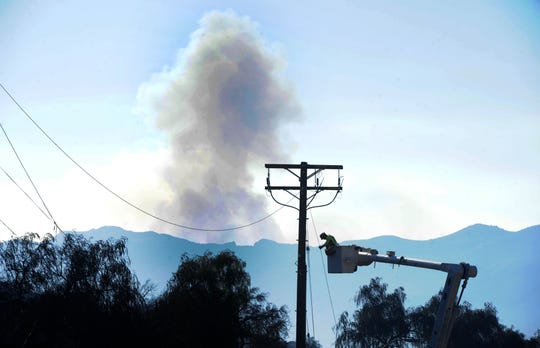Edison hires scientist to better predict where and when fires will start
--
__._,_.___
Southern California Edison announced last year it would shut off power in windy, dry weather to try to prevent its equipment from sparking a fire.
A year and another large, destructive fire later, the utility company may do so more often as conditions heat up and a bumper crop of grass and light vegetation dries out.
At this point, Edison says it's too soon to say.
"We don't know how often we'll have to turn off the power. We can't predict that," said Tom Rolinski, hired to build and manage a fire program for the company. "It's more accurate to say we'll be monitoring fuel and weather conditions more closely."
Since Edison launched the Public Safety Power Shutoff program last year, it upgraded the technology and expertise, adding super computers, installing more cameras and weather stations, and hiring Rolinski, a longtime fire weather scientist.
So far, the 2019 fire season hasn't gotten off to a big start.
Dried brush grows along Highway 33 near Oak View on Monday. (Photo: ANTHONY PLASCENCIA/THE STAR)
Last year, the California Department of Forestry and Fire Protection reported 2,615 fires had burned more than 145,000 acres through June 30. This year, the agency reported 1,795 fires burning roughly 18,300 acres.
A consistent marine layer made for gloomy June days but also staved off fire weather. The latest report from Ventura County Fire Department showed brush has dried out less than average for this time of the year.
Still, authorities said, even a little wind could mean fast-moving grass fires.
By late July or August, Rolinski expects the region to see larger and more frequent fires.
There's not only a lot more grass and lighter brush but it tends to be more accessible to the public, he said. "I would expect that we're going to have a lot more roadside ignitions later this summer when things dry out a little bit more."
 Buy Photo
Buy PhotoPersonnel from Southern California Edison repair lines Saturday at Old Conejo Road in Newbury Park where the Hill Fire burned. (Photo: JUAN CARLO/THE STAR)
Rolinski worked nearly 27 years for the federal government, starting in the National Weather Service and later spending much of his career with the U.S. Forest Service.
He worked in the Geographic Area Coordinator Center, which manages shared fire resources in the region. His job was to provide information about weather, vegetation and fire potential.
He also helped create the Santa Ana Wildfire Threat Index, a system that categorizes the hot, dry winds to help forecast fire conditions.
In Southern California, Santa Ana winds typically start in late September, after vegetation has dried out over summer months, and have led to some of the area's largest most destructive fires.
The winds not only cause vegetation to dry out even more, but also for fires to spread quickly.
No comments:
Post a Comment